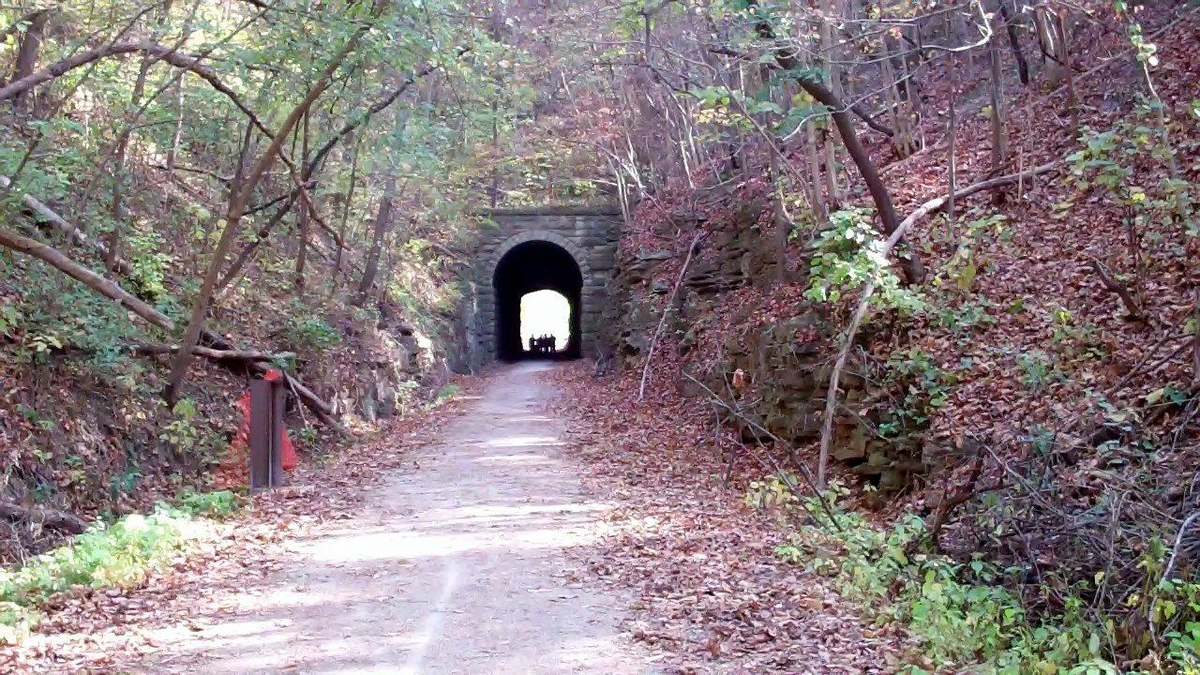By Lou Melini — It was November of 2022 that Julie told me her sister was planning a family reunion at Mt. Rushmore in South Dakota. Julie’s younger brother and sister and families reside in her home state of Wisconsin, with a nephew in Boise. When I heard Mt. Rushmore, I didn’t think of a stone monument of 4 presidents. I instead thought about the nearby Mickelson Trail, officially called the George S. Mickelson Trail, the former governor of South Dakota that championed the building of the trail. Riding the Mickelson and the surrounding area has been on a mini bucket list for quite some time.
The trail is a former rail line abandoned in 1983. In 1991 the first 6 miles was completed. The 109-mile trail was fully completed in 1998 spanning from Edgemont in the south to Deadwood in the north. The trail surface is primarily crushed limestone and gravel that is kept in immaculate condition. There are 15 trailheads along the trail, 11 that have water cisterns, sheltered picnic tables and vault toilets. The furthest distance between trailheads with the noted services is 16 miles.
There is a $4/day or a $15 annual pass to use the trail except within city limits. The fees go back to the trail. We rode on the trail about an hour after a heavy early morning storm. The trail was not affected by the rain except in one spot where water ran onto the trail. The previously mentioned water cisterns consist of 175-gallon tanks with a pump. The water is tested for quality twice weekly. It is a trail for all ages and abilities given the railroad grade of the trail. E-bikes seem to be the dominate bike on the trail. Rentals can be had in the cities that the trail passes through. We encountered one couple doing an overnight ride on the trail.
If the Mickelson trail is not enough for the gravel lover, there are perhaps hundreds of miles of gravel roads in the vicinity of the trail.
Preparing for the ride:
Julie has not liked riding gravel roads aside from a few short rides on bike trails, mostly comprised of crushed limestone in her home state of Wisconsin. I put 35C gravel bike tires on her touring bike for a ride on the Park City rail-trail to see how she would do. Julie did great though she realized that her position on her touring bike is no longer satisfactory since the 2005 build and the brakes are no longer adequate in part due to her hand arthritis. I did not think I could make the needed adjustments to her bike within the 2-week departure time so I went to Plan B, a new gravel specific bike that I knew my son Ben had in stock at Storm Cycles in Park City. I also have the same bike – a Trek Checkpoint SL5 gravel-specific bicycle. In addition to the new bikes, we used bike packing bags though we added rear racks and panniers to meet our needs to travel comfortably. We considered using flat pedals which would work great on the trail, but we opted to keep our clipped in style due to the hills of the area adjacent to the trail, primarily Custer State Park. Oh, I should mention that Julie had her left knee replaced in early January. This trip will be her first multiday bike tour since the knee replacement. Julie started the trip with a new knee, new bike, and a new gravel attitude.
Packing gear for the ride with the bike packing bags was an issue. I packed and repacked stuff perhaps 3 times making the most efficient use of the reduced space. Julie and I are used to having front and rear panniers and a handlebar bag for a total 75 liters of space on each of our bikes. We are never fully loaded but the extra space is nice for shopping at a grocery store that may include a personal sized watermelon if we wish. We travel comfortable which is neither light nor heavy depending on one’s definition of heavy.
The Ride:
Our trip consisted of 250 miles over 5 days. Short, but it was nice to get back on the bikes. This was our first bike trip since our (Yellowstone and Northwest Wyoming) 13-day ride just after Labor Day of 2021. Backpacking, including a 9-day Yellowstone walk, took up 2022.
The longest day on this tour was 65 miles on the trail and our shortest was just shy of 30 on the last day to return to our car. Of the 250 miles, 160 miles were on the gravel trail and 90 miles on pavement. I had planned on 45 to 50-mile pavement days and 35-40 gravel days. Campground locations were the dictating factor for our trip. Our ride occurred in late June with wetter and cooler than expected weather.
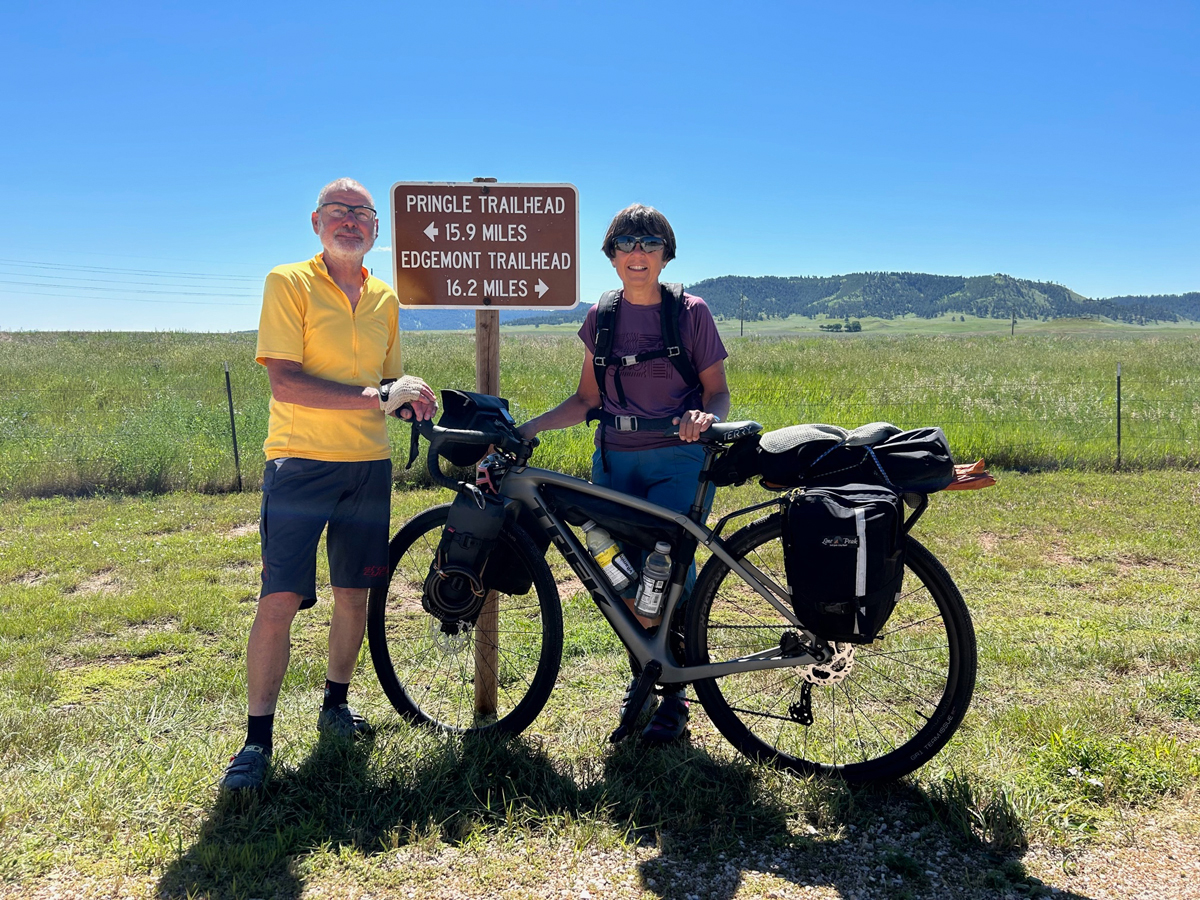
Hot Springs, South Dakota
We left our car at Spokane Creek campground just outside the northeast section of Custer State Park. Our route took us south on the wildlife loop road in Custer State Park. During a car ride with my son and family, we previously encountered a small herd of bison and wild donkeys along this road. On our bikes we saw the donkeys and some bison that were not along the road. From Custer State Park we went south past Wind Cave national park to Hot Springs, SD. The KOA was 5 miles east of Hot Springs, making for a 55-mile day. The ride on this day was mostly through rolling hills and forest traversing on the west side of Wind Caves NP. Traffic was relatively light.
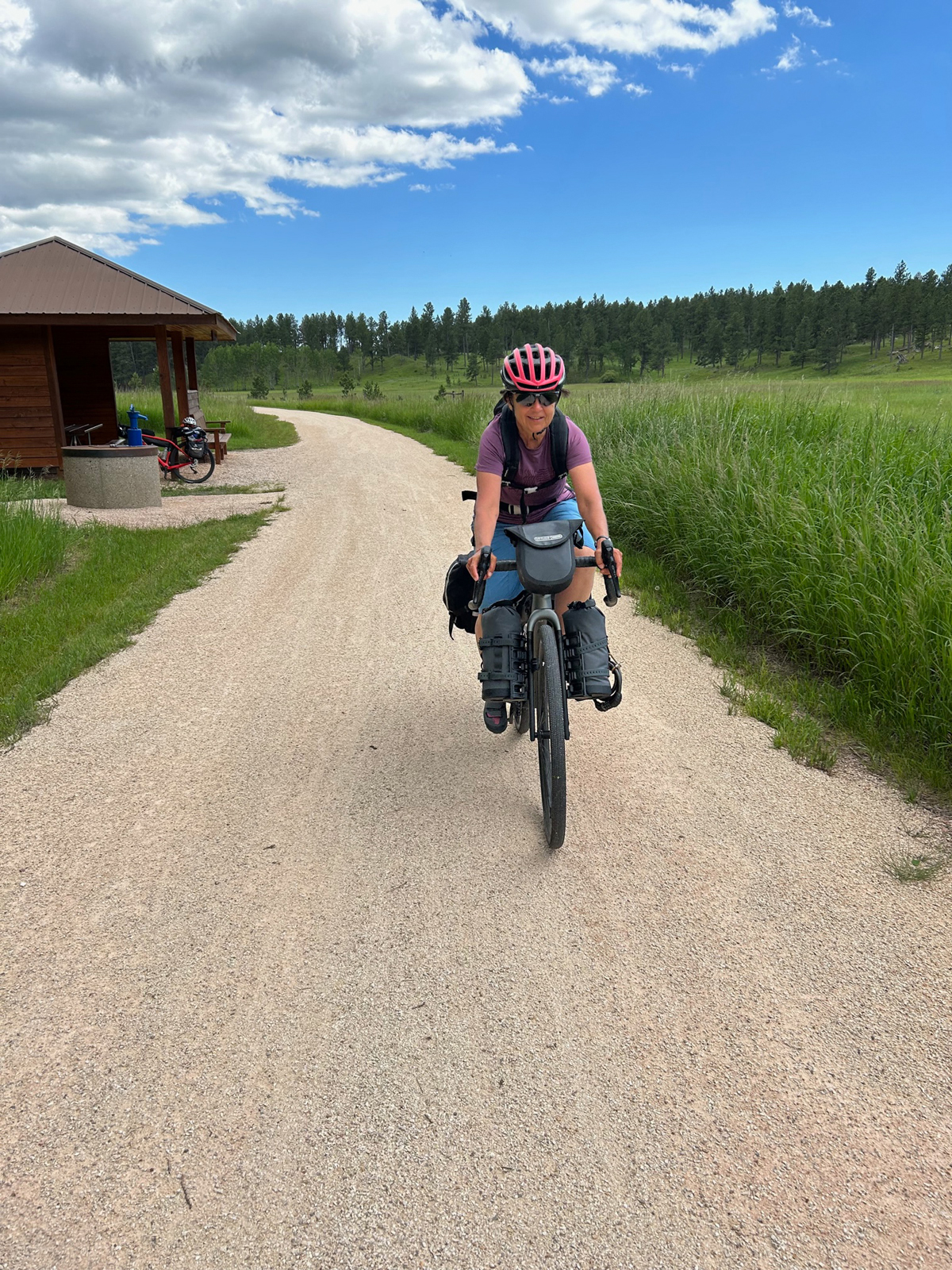
Custer:
On day 2 we rode 20 miles due west to our start on the Mickelson trail at the Minnekahta trailhead, mile 16 from the southern start of the trail. The first campground from Minnekahta trailhead going north is in Custer at milepost 46 resulting in a 50-mile day. Many of the local riders consider the trail from Minnekahta to Custer “boring” as it follows along highway 89 and runs through primarily ranchland. As we approached Custer, the “Black Hills” started to dominate the scenery.
When we set upon the trail, we found it in great condition. We talked to several folks during our ride that use the trail once or twice a week for casual rides. There is a lot of community pride in having the trail for local folks and the economic benefits from riders coming to the area to ride the Mickelson.
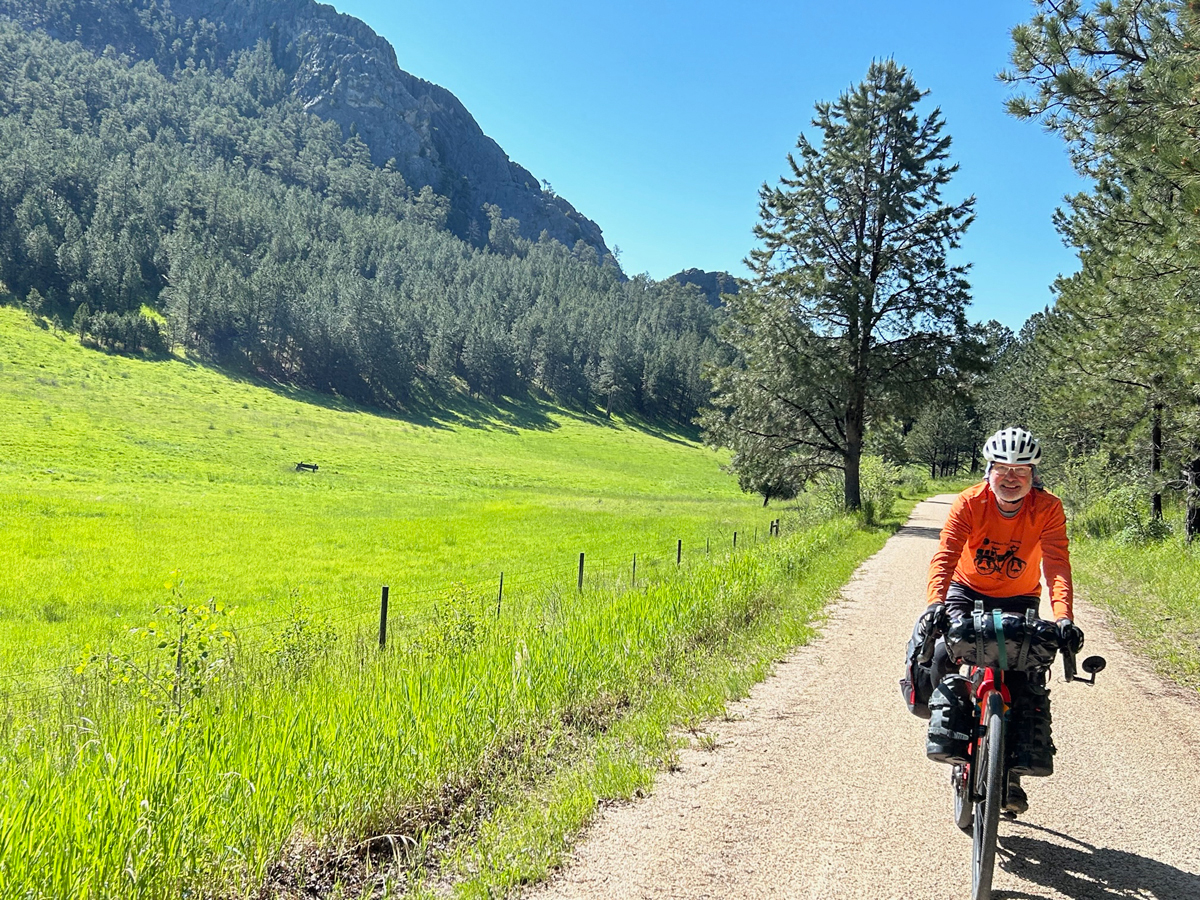
Deadwood:
Julie and I had a lot of discussion regarding Day 3. Julie was tired, quite tired, at the end of day 2. Despite that, we did walk to the Purple Pie (and ice cream) place for homemade pie for our dinner desert. Our two options for day 3 were a very short ride, about 15 miles, to Hill City or 65 miles to Deadwood, the next available (commercial) campground. There were Forest service campgrounds about 6 or more miles off the trail and there was a slight chance of finding Forest Service land to stealth camp along the trail. After looking at the map, we learned that the last 15 miles in Deadwood descended about 1600 feet.
We awoke at 5 AM for the predicted long day but had to deal with a thunderstorm with fairly heavy rain at that time. The campground office had a large overhanging roof with a picnic table so we picked up everything, including our tent, and set up camp there, had breakfast and packed up. The rain stopped shortly before we were ready to roll. The Mickelson trail is paved in town boundaries, but we were concerned that we would be riding on a muddy mess once we left the town limits. To our surprise, the trail was immaculate with only one small puddle to ride around. As we are fond of doing, we had a second breakfast after the 15-mile ride to Hill City. We were also able to see the Crazy Horse monument from the trail north of Custer.
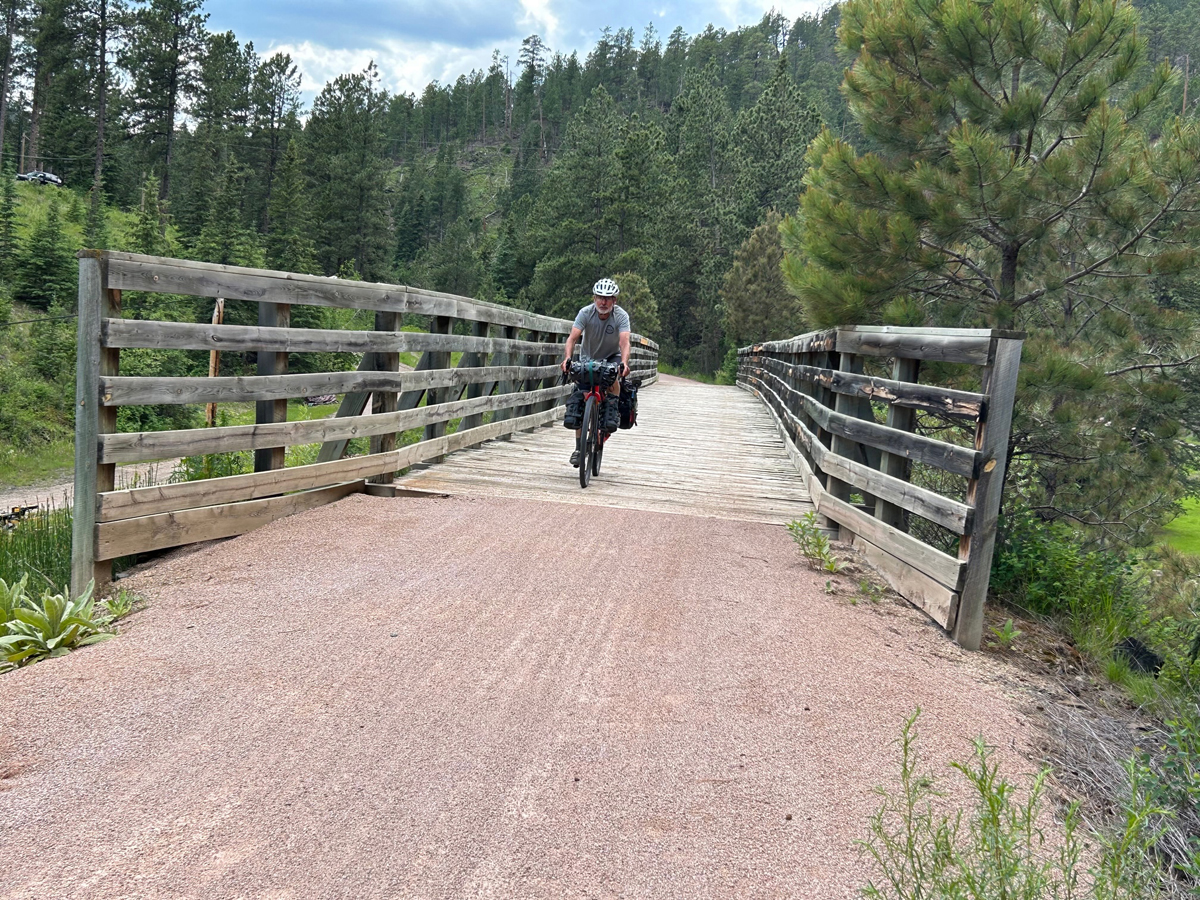
Leaving Hill City, we simply planned to keep a steady pace, stop when needed and enjoy the scenery to Deadwood. We stopped at trailheads along the way as needed for water and food. In between we experienced Black Hills beauty, crossed numerous wooden bridges, passed through three short tunnels, and saw a large number of cyclists, though not enough to slow our progress.
The first campground we came to in Deadwood made for a 67-mile day that took 6 hours and 30 minutes for a 10.2 average. We were both tired especially when we had to ride a quarter of a mile up a rather steep grade of a canyon to the tenting area. After dinner we walked back down the quarter mile for showers. The view was worth the ride up the hill.
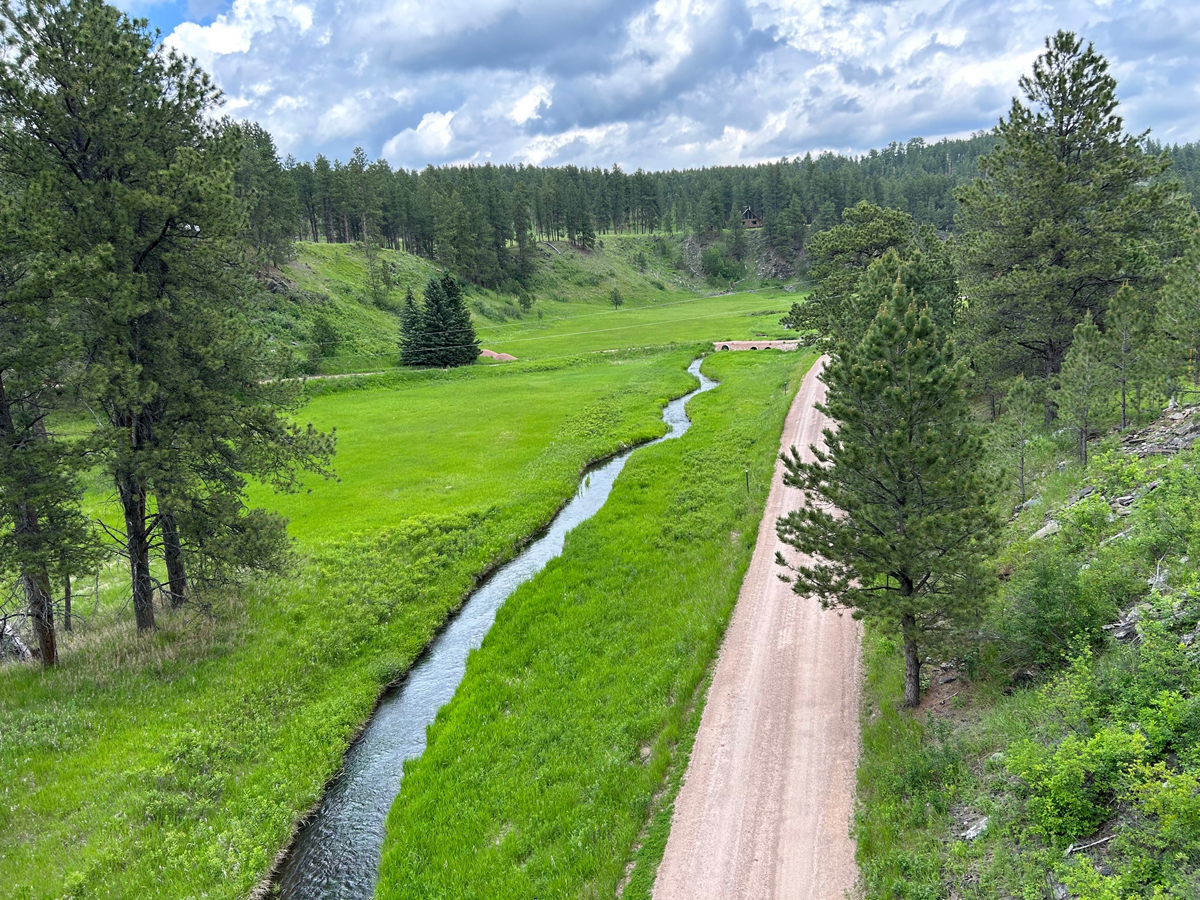
(Return to) Hill City:
Our legs knew we had a good ride yesterday but the ride back to Hill City was “only” 50 miles with a nearly 15-mile steady, railroad grade climb out of Deadwood and a similar 7-mile elevation change shortly before reaching Hill City. The trail had a few ruts in places from the many thunderstorms that recently came through the Black Hills. I noted that a trail crew had come through and patched up the ruts for the first mile or so of the trail out of Deadwood. We chatted it up with a lot of cyclists along the way including five from Salt Lake City (one with recognizable Contender Bicycle shorts). We also met and chatted with a trail crew testing water quality in the cisterns while others emptied the trash container and cleaned the vault toilet. You could see the pride that the community has invested in the trail. After a grocery store stop in Hill City, we rolled into a campground south of the city that was one of several along the trail adding a few miles to our day.
Custer State Park:
We rode to Custer and took the (paved) spur trail to the entrance station of Custer State Park. The entrance fee for cars to travel in the park is $20, a sum we had paid when we drove through Custer SP. Bicycles are free to enter the park. Despite the beauty of the park, there is not a lot of traffic, especially early in the day on weekdays. Weekends have a bit more traffic. The hills in the park are relatively short but steep. Even the spur trail we took had a steep ascent where Julie was in her lowest gear. The famous Needles Highway in the park is a twisty road with pigtail hairpins necessitating a 10-mph speed limit at one hairpin turn. On a different section of the needles road there are several short tunnels wide enough for one car. The Adventure Cycling Parks, Peaks and Prairies map has an alternate route through Custer State Park with the warning that “Proper caution should be taken during riding Needles Highway and it is not recommended during inclement weather.” The short section of the Needles Hwy that Julie and I rode to get back to the campground and our car was a pleasant ride. There was little traffic that was patient with our presence.
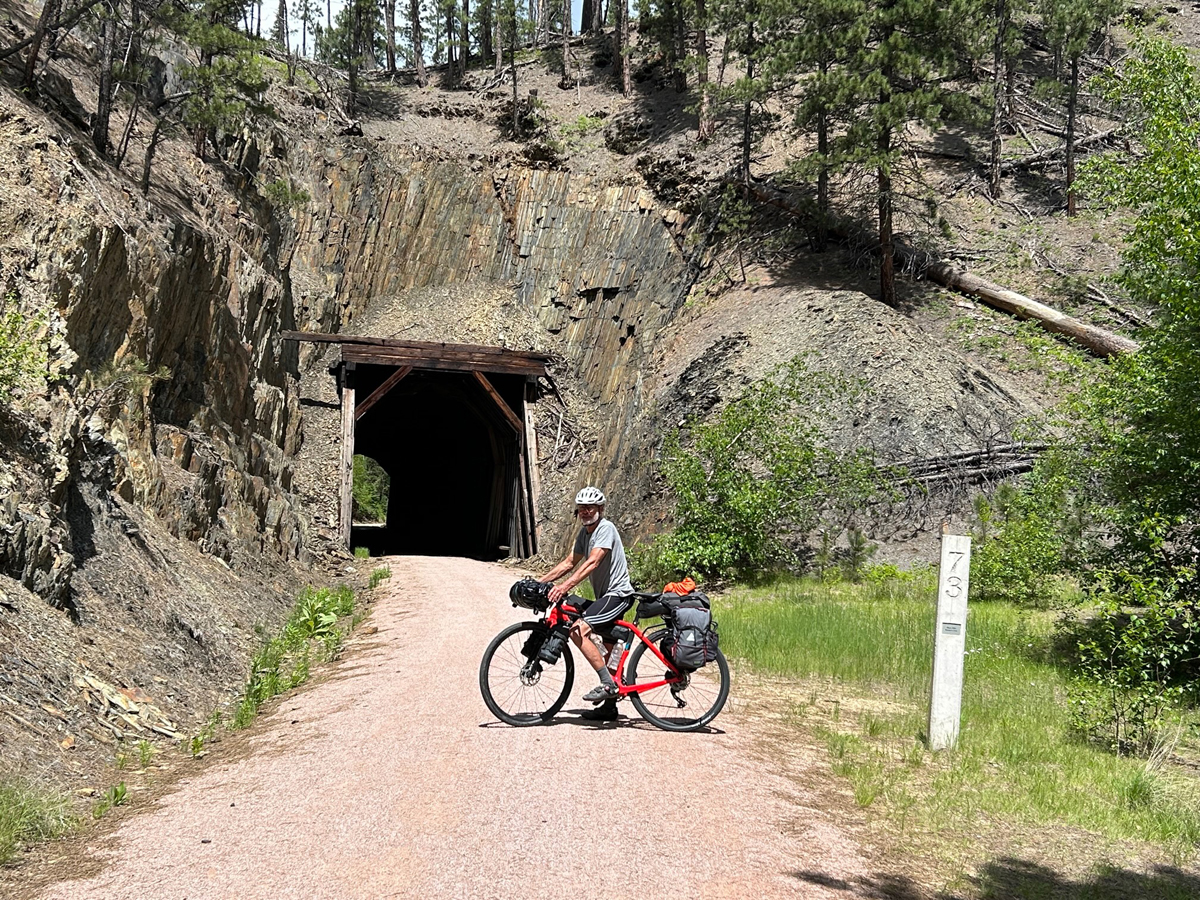
Citing tradition, Julie and I opted for the campground café pizza, something we have done on the last night of many of our trips (usually having pizza delivered from a pizza place). It also saved us from schlepping food from Custer City. If folded over the pizza would have looked like an Italian Quesadilla as it lacked sauce. We gave what we didn’t eat to the appreciate young campers near us from Canada. Fortunately, we bought a bagged salad kit in Custer to go with the meal. After the early dinner we went to the Black Hills Theater, 4 miles from the campground and saw the Silent Sky, a production about pioneering women in astronomy. Even considering the pizza, it was a great way to end our short journey on the Mickelson Trail.
Nuts and Bolts:
Julie and I like to tent camp. Since the Covid-19 pandemic, acquiring tent sites meant making reservations. On this trip we could rode into each campground and had a tent site. Prices ranged from $24 one block from the Custer City trail head to $58 for a tent site in a campground with many amenities such as outdoor kitchens if you wished. On the other nights we paid, $30, $36, and at the campground where our car was located, $40.
The weather for South Dakota was unseasonably wet and cool for the end of June. Thunderstorms lasting about 30 minutes or so hit mostly from 6 PM to 5 AM.
Custer State Park is a very scenic park that is not visited by the crowds going to Mt. Rushmore and Crazy Horse Monuments. It is worth riding through it but go early and on a weekday.
We rode with 40C width tubeless tires. The set-up worked well. The wider tires compared to our road touring bikes gave us plenty of stability. Given the quality of the Mickelson Trail, one could ride a narrower tire. I would be OK with a 35 C tire but probably nothing smaller, but others might.








